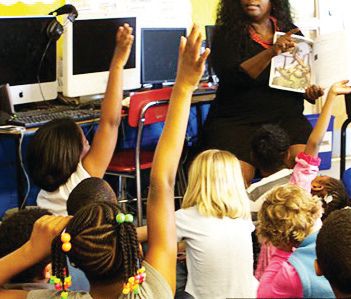Black Girls Kicked Out Of School In Record Numbers
By Anisah Muhammad | Last updated: Jan 12, 2016 - 6:03:58 PMWhat's your opinion on this article?

|
“Far too many students across the country find themselves suspended, expelled, or involved with the criminal justice system for misbehaviors that occur during school,” explained Congressman Cedric Richmond (D-La.) in the executive summary of a report by the Penn Graduate School of Education (PGSE).
“Making all of this worse is the fact that these punishments are not applied equally. From the data available, we know that Black students are disproportionately suspended, expelled, and referred to the criminal justice system by schools. The overuse of these punishments and their disproportionate use on students of color are serious problems that we have to address right now.”
Nationally, over three million public school students received at least one out-of-school suspension and 130,000 were expelled during the 2011-2012 academic year according to the U.S. Department of Education, 2014.
According to the report released last month by PGSE, “Disproportionate Impact of K-12 School Suspension and Expulsion On Blacks in Southern States," Blacks were nearly half of all students suspended and expelled from public schools in the South.
According to the report, 427,768 Black boys were suspended and 14,643 were expelled, the highest numbers among both sexes and all racial/ethnic groups. Blacks were 56 percent of girls suspended and 45 percent of girls expelled, the highest percentages among both sexes and all racial/ethnic groups.
Columbia Law School Professor Kimberlé Williams Crenshaw and colleagues explained the gravity of the situation in their 2015 report, Black Girls Matter: Pushed Out, Overpoliced, and Underprotected. They found that 90 percent of all girls expelled from New York City public schools in 2011-12 were Black.
“The imposition of harsh disciplinary policies in public schools is a well-known risk factor for stunted educational opportunities for Black and Latino boys,” the report says. “Such punishments also negatively affect their female counterparts … The risks that Black and other girls of color confront rarely receive the full attention of researchers, advocates, policymakers and funders,” she noted.
Ms. Crenshaw says girls of color are “doubly vulnerable” facing gender stereotypes like Caucasian girls and racial stereotypes like Black boys.
“Girls tend to be disciplined when they do things that are non-normatively feminine, like when they get into beef with each other,” she says.
The racial problem is compounded because as she explains in the report, “Blacks tend to be seen as threatening because, by nature, people assume they’re more aggressive.”
In 2014, 12-year-old Mikia Hutchings, a student in Georgia’s Henry County School District was threatened with expulsion for writing the word “Hi” on a locker room wall. After her grandmother protested she was sentenced to suspension.
A Florida school in 2013 threatened 12-year-old Vanessa VanDyke with expulsion for not cutting her natural hair. They called it a distraction.
The PSGE report recommends first and foremost doing away with zero tolerance school discipline policies which were supposedly established to create safer learning environments for all students.
However these policies are often enacted through rigid practices and predetermined consequences that greatly limit discretion in individual cases, usually remove students from schools, and occasionally involve law enforcement personnel.
The Black Girls Matter report calls for the development of policies and programmatic interventions that address the challenges facing Black girls and other girls of color. Their recommendations – developed from interviews with young women directly affected by contemporary school policies and with stakeholders invested in their futures – are as follows:
*Develop protocols that ensure student’s rights to learn in an environment free of sexual harassment and bullying.
*Review and revise policies that funnel girls into the juvenile justice system.
Devise programs that identify the signs of sexual victimization in order to support girls who have been traumatized by violence.
*Advance and expand programs that support girls who are pregnant, parenting or otherwise assuming significant family responsibilities.
INSIDE STORIES AND REVIEWS
-
-
About Harriett ... and the Negro Hollywood Road Show
By Rabiah Muhammad, Guest Columnist » Full Story -
Skepticism greets Jay-Z, NFL talk of inspiring change
By Bryan 18X Crawford and Richard B. Muhammad The Final Call Newspaper @TheFinalCall » Full Story -
The painful problem of Black girls and suicide
By Charlene Muhammad -National Correspondent- » Full Story -
Exploitation of Innocence - Report: Perceptions, policies hurting Black girls
By Charlene Muhammad -National Correspondent- » Full Story -
Big Ballin: Big ideas fuel a father’s Big Baller Brand and brash business sense
By Bryan Crawford -Contributing Writer- » Full Story






 Click Here Stay Connected!
Click Here Stay Connected!








